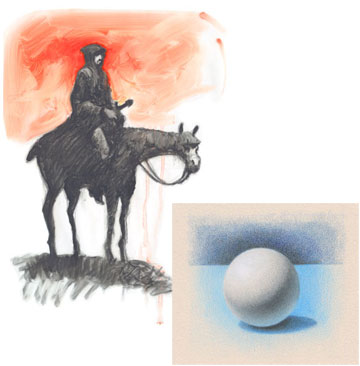view online at https://www.tasart.co.nz/email/mailout.php?content_id=14
Hi , welcome to issue #14 of the Tasart newsletter. Belated Happy New Year to you all. We are back in full swing after having a short break over Christmas and New Year. There are about 6 regulars who come to The Saturday Workshops, and you can really see the work grow over the past year and a half. We put some of the work up on Facebook for everyone to see, if you're interested.
This April will be our 5th year as proprietor's of Takapuna Art Supplies, and although we haven't even come close to reaching all the goals we've set for ourselves and for the store, we look back and can't believe all that we've accomplished. When we bought the shop in 2007, there wasn't a computer on site and now half of our customers are online. Early on, we decided that we would never gain brand agencies because as artist's, we find it unethical and bias. We choose to support all brands and most importantly to support our New Zealand suppliers, giving artist's a selection like the stores we've always enjoyed shopping in. What does that mean for you? Well, because we're not tied down with agency contracts and quotas, we are prepared to import almost anything that isn't already available in New Zealand. We can add single items to our orders for customers who are curious to try certain products they've read about in books or on the internet. And, we often take suggestions from customers on new lines. This freedom has made us a customer friendly store and we're proud to be a store focused on choice.The Much Maligned Coloured Pencil

In a previous newsletter, we showcased the work of Terrie Reddish, a talented botanical artist who works in coloured pencil. Terrie primarily uses oil-based Faber-Castell Polychromo Pencils. In this newsletter, we'll talk about waxed-based pencils and use them on a variety of surfaces.
Not all coloured pencils are alike but there's nothing wrong with combining several types and brands. Oil-based pencils are hard, making them suitable for fine detail. Pencils like Colorsoft and Prismacolor Pencils are wax-based, making them softer and easily blended. Colorsoft and Prismacolor also make a solvent in a pencil form but you can also blend them using a liquid solvent like Winsor & Newton Sansodor or Art Spectrum Odourless Solvent. This method allows the blending of several colors, quickly.
The title illustration above was done with Prismacolor and Derwent Coloursoft pencils on Art Spectrum Colourfix paper. The hat was underpainted with acrylic paint and additional texture in the hat was created using Liquitex Matte Medium as a ground.

Concept drawing, like the knight on the horse, can be done on a heavy weight tracing paper, with tones created quickly, using a solvent. You can also use this method on any heavy weight paper that takes wet media. If you'd like to painstakingly render form, like the sphere example, this can also be achieved with patience. This sphere was rendered on the new Art Spectrum Colour Suede paper which has a velvety tooth.

The unveiling of la Stig was made by mounting a graphite drawing onto double weight, hot press illustration board. The surface was then sprayed using an airbrush and Liquitex Matte Medium to create a light texture. The airbrushed surface creates the perfect tooth to take a light 'dry brush' effect.
For information about The Colored Pencil Society, click here.
Getting Down to Business
Choosing the Right Class or Workshop
There are loads of courses and workshops taking place in and around New Zealand. To get the most out of your class, we've compiled a quick check list of questions you should satisfy before signing on.
The first question you should be asking is, "What do I want to get out of my class?" If you want a time and place to meet up with like-minded people to explore your own avenues, there are several untutored groups getting together once a week to draw and paint and exchange ideas.
If you'd like professional tutoring, you'll want to get the most out of your money and experience, so it's wise to ask a lot of questions. Get instructor referrals, and ask specifically, what will be covered. In addition, do a thorough check on the instructor. Does he or she work as a professional? If so, for how long and where can you view the instructor's work?
Remembering the old adage "Those that can, do and those who can't, teach", the most important question to ask, is whether the instructor will be giving demos and sharing their experience as a working professional. If the instructor doesn't give demos, our opinion is, don't waste your time and money.
And lastly, beware, if an instructor is pushing certain brands of artist materials, chances are they're getting some sort of kick-back on products from the manufacturer or importer. The same goes for specific product endorsements in books. Many art material manufacturers "accredit" instructors, but this accreditation is just a sly strategy to promote their products. A brand doesn't make an artist. A good instructor should share what works for them and encourage their students to experiment with a variety of materials and discover which products are best suited for you and your artistic voice.
* * *
Until next time,
Sandy & Jim
Takapuna Art Supplies
www.tasart.co.nz
Subscription
SUBSCRIBE:
You can subscribe to The Artist's Newsletter at www.tasart.co.nz/email/
UNSUBSCRIBE:
You can unsubscribe by changing your account preferences at www.tasart.co.nz/account/profile or by following this link:
http://www.tasart.co.nz/email/optout.php?rid=&vid=759&eid=
Comments
We'd love to hear from you! If you have any suggestions on how we can improve this newsletter please send comments to info@tasart.co.nz
* * *
This newsletter was written by Sandy Collins on 2012-02-16
…
© Takapuna Art Supplies. All Rights Reserved. www.tasart.co.nz